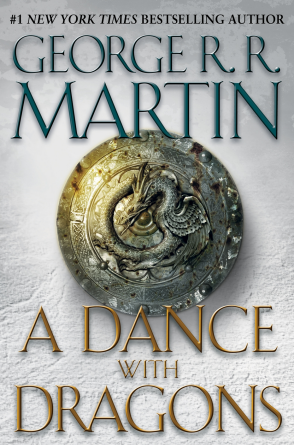By Jennifer Colbourne (The Cascade) – Email
Print Edition: April 11, 2012
 The A Song of Ice and Fire series, better known by its television adaptation Game of Thrones, got off to a great start with the first book. However, as it progressed, the series went into decline nearly as quickly as the house of Stark, hitting rock bottom with George R. R. Martin’s tedious fourth book, A Feast for Crows, which, rotten and unappealing as it was, was a feast for crows indeed.
The A Song of Ice and Fire series, better known by its television adaptation Game of Thrones, got off to a great start with the first book. However, as it progressed, the series went into decline nearly as quickly as the house of Stark, hitting rock bottom with George R. R. Martin’s tedious fourth book, A Feast for Crows, which, rotten and unappealing as it was, was a feast for crows indeed.
A Dance with Dragons, book five, runs along the same time-span as A Feast for Crows. When writing A Feast for Crows, Martin realized that the book was going to be much longer than the first three books and so, rather than splitting the book into two parts, he divided up the characters by location. This move is what absolutely killed the fourth book.
Situated in the South of Westeros (as well as the Iron Islands), A Feast for Crows got largely saddled with the less interesting characters, the worst of these without a doubt being Brienne of Tarth. The few characters that had some potential—such as Arya Stark and Jaime Lannister—undergo such drastic changes to their personalities that they lose whatever appeal they originally had in the series. What, after all, is Arya without her spirited defiance or Jaime without his charming arrogance? Martin effectively neuters them both. As for Cersei Lannister, she has gotten even more unappealingly cruel, to the point where the reader has lost all sympathy or interest for her. Furthermore, as there isn’t a lot of action in the South, and perhaps in an effort to draw out the book, the scenes were unnecessarily long and, frankly, dull as dirt.
With A Feast for Crows being such a bore, the expectations were definitely raised for the fifth book. A Dance with Dragons has some of the best characters of the series: Jon Snow, Bran Stark, Theon Greyjoy, and, most importantly, the dwarf Tyrion Lannister and mother of dragons Daenerys Targaryen. Also, along with this great cast of characters were supposed to be all the interesting plot developments, as the action of this time period is largely located in the North and overseas where all the major changes are happening.
It was a huge disappointment, then, to find that the fifth book was nearly as dull as the fourth. Nothing happens. Everything is slowly drawn out, hinting at great upheavals in the future – which would be fine, except this has essentially been what’s been going on for the entire series. Readers expect something marvelous—or even interesting—to happen, but are left disappointed and hanging again and again.
It doesn’t help that by this point, George R. R. Martin’s bag of tricks is getting old too. He keeps trying to up the ante with more and more grotesque scenes and unexpected deaths – it’s no wonder HBO picked up the series. The characters seem to deal with trauma after trauma with unrealistic aplomb. Common sense tells us that most of these characters’ experiences would leave them psychological disasters, but at the most they may squeeze out a tear before they shrug life’s horrors off. The entire world Martin has built utterly lacks humanity, and so it is difficult to really draw close to such unrelatable, stoic characters.
And, while A Dance with Dragons undoubtedly has the better group of characters, they too seem to fall away from their quintessential, endearing traits. Jon Snow and Bran Stark are downright boring and ponderously sententious; you would think they were old men, not boys. Theon Greyjoy, once proud and defiant, is pathetic and subservient. Daenerys is neither feisty nor ambitious, and sits around doing nothing and complaining about it. The best of the lot is definitely Tyrion Lannister, though his abilities as an active player are seriously limited from his fall from power, and his lovable wit is somewhat dampened by his bitterness and depression.
Perhaps worst of all, the book is also inconsistent, as characters who were supposed to be relegated to the fourth book start to appear in the second half of A Dance with Dragons. It seems out of place to have Arya, Cersei and Jaime show up again; logically, the ends of their stories could and should have been put in the fourth book.
It doesn’t help that splitting up the characters was a bad idea in the first place. Martin should have just published the entire timeline in two parts and had all the characters dispersed throughout the storyline like the first three books. As it stands, the fourth and fifth books are anomalous and frustrating to read; in the fourth, you want to know what’s going on with the rest of the characters. In the fifth, you feel like you’re backtracking. Of course, it doesn’t help that not much is going on in either.
Ultimately, like A Feast for Crows, A Dance with Dragons seems to be little more than filler; which makes sense, considering George R. R. Martin’s original intention was to make a five-year jump after book three, but found the time gap unmanageable. If you’re into the series, you’ll probably want to read book five despite its failings, but don’t expect much. All we can do is hope that Martin picks up his game in book six.


